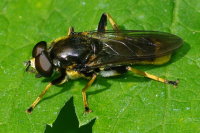Phylum Arthropoda (Arthropods) ➔ Subphylum Hexapoda (Hexapods) ➔ Class Insecta (Insects) ➔ Order Diptera (True flies) ➔ Family Syrphidae (Hoverflies)
Xylota sylvarum (Linnaeus, 1758)
Goldhaar-Langbauchschwebfliege
Synonyms and other combinations:
Musca longisco Harris, 1780 | Musca silvarum Hoslin, 1782 | Syrphus impiger Rossi, 1790 |
Classification:
Xylota sylvarum belongs to the subfamily Eristalinae, tribe Milesiini.Distribution:
From Fennoscandia south to Iberia; from Ireland eastwards through much of northern and central Eurasia to the Pacific coast; known in southern Europe from Italy, the former Yugoslavia, Greece and Turkey.Habitat:
Forest edges and open areas of humid dediduous and mixed forest with mature and over-mature trees, also urban parks; along streams in broad-leaved evergreen oak forest.Description:
Body length 11 - 16 mm; males much larger than females; abdomen black, at the end dense and golden yellow hairy; hind tibiae black at the apex.Similar species:
The similar looking Xylota xanthocnema has entirely yellow hind tibiae.Biology:
Xylota sylvarum flies from end of May to September. It is not clear whether the summer animals represent a second generation or later emerged offspring from the previous year.Xylota sylvarum occasionally visits the flowers of umbellifers, Ranunculus and Rubus idaeus. The adults also eat pollen grains that have fallen on leaves.
The saproxylic larvae live in moist, fungus-infested, decaying wood, under the bark of tree trunks and stumps, as well as in decaying tree roots of deciduous and coniferous trees. Larvae of the species were found in decaying dead wood of beech, oak, ash, aspen, fir, pine, spruce, douglas-fir and moist sawdust.
Xylota sylvarum overwinters as a larva.
References, further reading, links:
- Pape T. & Thompson F.C. (eds) (2017). Systema Dipterorum (version 2.0, Jan 2011). In: Species 2000 & ITIS Catalogue of Life, 2017 Annual Checklist (Roskov Y., Abucay L., Orrell T., Nicolson D., Bailly N., Kirk P.M., Bourgoin T., DeWalt R.E., Decock W., De Wever A., Nieukerken E. van, Zarucchi J., Penev L., eds.). Digital resource at www.catalogueoflife.org/annual-checklist/2017. Species 2000: Naturalis, Leiden, the Netherlands. ISSN 2405-884X.
- Gerald Bothe: Bestimmungsschlüssel für die Schwebfliegen (Diptera, Syrphidae) Deutschlands und der Niederlande, DJN, 1984, ISBN 3-923376-07-3
- M.C.D.Speight: Species Accounts of European Syrphidae (Diptera), Glasgow 2011, Syrph the Net, the database of European Syrphidae, vol. 65, 285 pp., Syrph the Net publications, Dublin.
- Menno Reemer, Willem Renema, Wouter van Steenis, Theo Zeegers, Aat Barendregt, John T. Smit, Mark P. van Veen, Jeroen van Steenis, Laurens van der Leij: De Nederlandse Zweefvliegen (Diptera: Syrphidae), Nederlandse Fauna 8, 2009.
- Speight, M.C.D. & Sarthou, J.-P. (2014) StN keys for the identification of the European species of various genera of Syrphidae (Diptera) 2014 / Clés StN pour la détermination des espèces Européennes de plusieurs genres des Syrphidae (Diptères) 2014. Syrph the Net, the database of European Syrphidae, Vol. 80, 125 pp, Syrph the Net publications, Dublin
- Anasimyia interpuncta
- Anasimyia transfuga
- Baccha elongata
- Blera fallax
- Brachyopa sp.
- Brachypalpoides lentus
- Brachypalpus laphriformis
- Brachypalpus sp.
- Brachypalpus valgus
- Ceriana conopsoides
- Ceriana vespiformis
- Chalcosyrphus femoratus
- Chalcosyrphus nemorum
- Chalcosyrphus valgus
- Cheilosia albipila
- Cheilosia albitarsis
- Cheilosia chrysocoma
- Cheilosia illustrata
- Cheilosia pagana
- Cheilosia scutellata
- Cheilosia sp.
- Cheilosia variabilis
- Chrysogaster sp.
- Chrysotoxum bicinctum
- Chrysotoxum fasciatum
- Chrysotoxum festivum
- Chrysotoxum verralli
- Criorhina berberina
- Dasysyrphus albostriatus
- Dasysyrphus sp.
- Dasysyrphus tricinctus
- Didea fasciata
- Didea intermedia
- Didea sp.
- Epistrophe diaphana
- Epistrophe eligans
- Epistrophe flava
- Epistrophe grossulariae
- Epistrophe melanostoma
- Epistrophe melanostoma/nitidicollis
- Epistrophella euchroma
- Episyrphus balteatus
- Eristalinus aeneus
- Eristalinus megacephalus
- Eristalinus taeniops
- Eristalis arbustorum
- Eristalis interrupta
- Eristalis intricaria
- Eristalis lineata
- Eristalis pertinax
- Eristalis rupium
- Eristalis similis
- Eristalis sp.
- Eristalis tenax
- Eumerus purpurariae
- Eumerus sp.
- Eupeodes corollae
- Eupeodes luniger
- Eupeodes sp.
- Eurimyia lineata
- Ferdinandea cuprea
- Hammerschmidtia ferruginea
- Helophilus hybridus
- Helophilus pendulus
- Helophilus sp.
- Helophilus trivittatus
- Ischiodon aegyptius
- Leucozona glaucia
- Leucozona laternaria
- Leucozona lucorum
- Melangyna lasiophthalma
- Melangyna quadrimaculata
- Melangyna umbellatarum
- Melanogaster sp.
- Melanostoma scalare
- Meligramma triangulifera
- Meliscaeva cinctella
- Merodon ambiguus
- Merodon avidus
- Merodon equestris
- Merodon moenium
- Merodon obscuritarsis
- Merodon sp.
- Microdon analis/major
- Microdon mutabilis/myrmicae
- Myathropa florea
- Myolepta dubia
- Orthonevra sp.
- Paragus sp.
- Parasyrphus lineolus
- Parhelophilus sp.
- Pipiza austriaca
- Pipiza bimaculata
- Pipiza fenestrata
- Pipiza quadrimaculata
- Pipiza sp.
- Platycheirus rosarum
- Platycheirus sp.
- Rhingia campestris
- Rhingia rostrata
- Scaeva albomaculata
- Scaeva pyrastri
- Scaeva selenitica
- Sericomyia lappona
- Sericomyia silentis
- Sphaerophoria rueppelli
- Sphaerophoria scripta
- Sphaerophoria sp.
- Sphegina sp.
- Spilomyia saltuum
- Syritta pipiens
- Syrphus ribesii
- Syrphus sp.
- Syrphus vitripennis
- Temnostoma bombylans
- Temnostoma meridionale
- Temnostoma vespiforme
- Tropidia scita
- Volucella bombylans
- Volucella inanis
- Volucella inflata
- Volucella pellucens
- Volucella zonaria
- Xanthogramma citrofasciatum
- Xanthogramma pedissequum
- Xylota segnis
- Xylota sp.
- Xylota sylvarum




